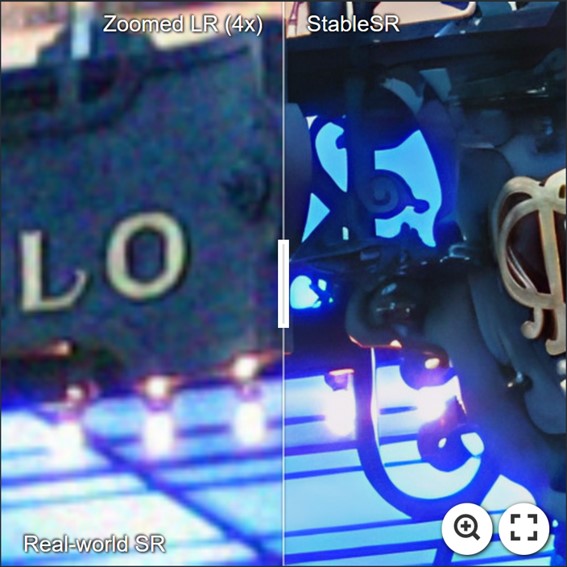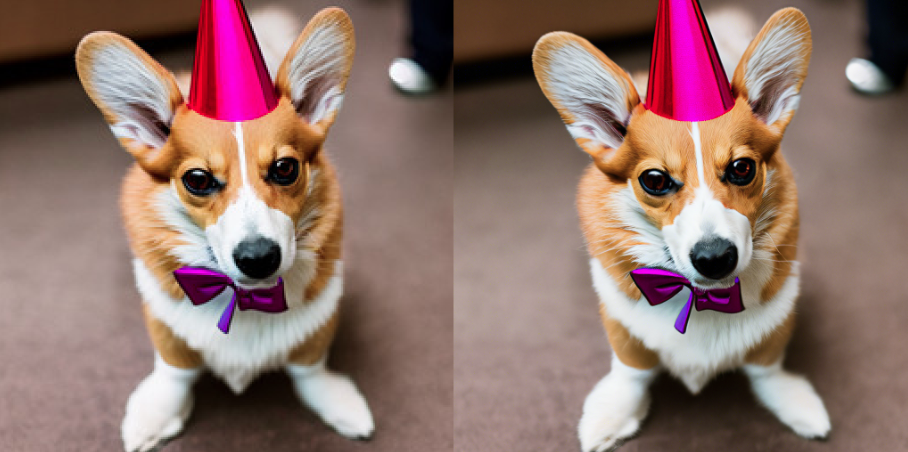stablesr
Maintainer: iceclear

4

| Property | Value |
|---|---|
| Run this model | Run on Replicate |
| API spec | View on Replicate |
| Github link | View on Github |
| Paper link | View on Arxiv |
Create account to get full access
Model overview
The StableSR model is a diffusion-based image super-resolution model developed by Jianyi Wang. It is an extension of the Stable Diffusion model, incorporating a time-aware encoder and a controllable feature wrapping (CFW) module to generate high-quality super-resolved images. The model is licensed under the S-Lab License 1.0.
Similar models include the stable-diffusion-xl-refiner-1.0 and stable-diffusion-2 models, which also use diffusion-based approaches for image generation and manipulation.
Model inputs and outputs
Inputs
- Low-resolution images
Outputs
- High-resolution images based on the input low-resolution images
Capabilities
The StableSR model is capable of generating high-quality super-resolved images from low-resolution inputs. It leverages the power of diffusion models to produce visually appealing results, maintaining fidelity to the original content while adding detailed textures and structures.
What can I use it for?
The StableSR model can be used for a variety of image enhancement and creative applications. It could be employed in tasks such as upscaling low-resolution images, generating high-quality artwork from sketches, and improving the visual quality of images for design or artistic purposes. However, the model's use is subject to the terms of the S-Lab License 1.0.
Things to try
Practitioners can experiment with the StableSR model to see how it performs on different types of low-resolution images, such as landscapes, portraits, or detailed scenes. They can also try varying the input resolutions and observe the model's ability to generate high-quality super-resolved outputs. Additionally, exploring the model's performance under different real-world scenarios could yield interesting insights about its capabilities and limitations.
This summary was produced with help from an AI and may contain inaccuracies - check out the links to read the original source documents!
Related Models
🔍
StableSR

94
The StableSR model is a diffusion-based image super-resolution model developed by Jianyi Wang. It is an extension of the Stable Diffusion model, incorporating a time-aware encoder and a controllable feature wrapping (CFW) module to generate high-quality super-resolved images. The model is licensed under the S-Lab License 1.0. Similar models include the stable-diffusion-xl-refiner-1.0 and stable-diffusion-2 models, which also use diffusion-based approaches for image generation and manipulation. Model inputs and outputs Inputs Low-resolution images Outputs High-resolution images based on the input low-resolution images Capabilities The StableSR model is capable of generating high-quality super-resolved images from low-resolution inputs. It leverages the power of diffusion models to produce visually appealing results, maintaining fidelity to the original content while adding detailed textures and structures. What can I use it for? The StableSR model can be used for a variety of image enhancement and creative applications. It could be employed in tasks such as upscaling low-resolution images, generating high-quality artwork from sketches, and improving the visual quality of images for design or artistic purposes. However, the model's use is subject to the terms of the S-Lab License 1.0. Things to try Practitioners can experiment with the StableSR model to see how it performs on different types of low-resolution images, such as landscapes, portraits, or detailed scenes. They can also try varying the input resolutions and observe the model's ability to generate high-quality super-resolved outputs. Additionally, exploring the model's performance under different real-world scenarios could yield interesting insights about its capabilities and limitations.
Updated Invalid Date

stable_diffusion2_upscaling

7
The stable_diffusion2_upscaling model is an image super-resolution model based on the Stable Diffusion 2 architecture. It can be used to upscale low-resolution images by a factor of 4, preserving important details and producing high-quality, photorealistic results. This model is similar to other Stable Diffusion-based models like Stable Diffusion, Stable Diffusion Upscaler, and Stable Diffusion x4 Upscaler, but is specifically focused on the high-resolution upscaling task. Model inputs and outputs The stable_diffusion2_upscaling model takes a low-resolution image as input and outputs a high-resolution version of the same image, upscaled by a factor of 4. The model is designed to preserve important details and maintain a photorealistic appearance in the upscaled output. Inputs input_image**: The low-resolution image to be upscaled, provided as a URI. ddim_steps**: The number of denoising steps to use during the upscaling process, with a default of 50 and a range of 2 to 250. ddim_eta**: The upscale factor, with a default of 0 and a range of 0 to 1. seed**: An integer seed value to control the randomness of the upscaling process. Outputs Output**: An array of one or more high-resolution images, represented as URIs. Capabilities The stable_diffusion2_upscaling model can take low-resolution images and significantly increase their resolution while preserving important details and maintaining a photorealistic appearance. This can be useful for tasks such as enhancing product images, upscaling old photographs, or creating high-quality visualizations from low-res sources. What can I use it for? The stable_diffusion2_upscaling model can be used in a variety of applications that require high-resolution images, such as: E-commerce**: Upscaling product images to improve the visual appeal and detail for customers. Photography**: Enhancing old or low-quality photographs to create high-quality prints and digital assets. Graphic design**: Generating high-resolution images for use in designs, presentations, or marketing materials. Video production**: Upscaling low-res footage or animation frames to improve visual quality. Things to try Some interesting things to try with the stable_diffusion2_upscaling model include: Experimenting with different ddim_steps and ddim_eta values to find the optimal balance between speed and quality. Applying the model to a variety of image types, from natural scenes to abstract art, to see how it handles different visual styles. Combining the upscaling model with other Stable Diffusion models, such as the Stable Diffusion Inpainting or Stable Diffusion Img2Img models, to create even more powerful image generation and manipulation workflows.
Updated Invalid Date
📊
stable-diffusion-xl-refiner-1.0

1.5K
The stable-diffusion-xl-refiner-1.0 model is a diffusion-based text-to-image generative model developed by Stability AI. It is part of the SDXL model family, which consists of an ensemble of experts pipeline for latent diffusion. The base model is used to generate initial latents, which are then further processed by a specialized refinement model to produce the final high-quality image. The model can be used in two ways - either through a single-stage pipeline that uses the base and refiner models together, or a two-stage pipeline that first generates latents with the base model and then applies the refiner model. The two-stage approach is slightly slower but can produce even higher quality results. Similar models in the SDXL family include the sdxl-turbo and sdxl models, which offer different trade-offs in terms of speed, quality, and ease of use. Model Inputs and Outputs Inputs Text prompt**: A natural language description of the desired image. Outputs Image**: A high-quality generated image matching the provided text prompt. Capabilities The stable-diffusion-xl-refiner-1.0 model can generate photorealistic images from text prompts covering a wide range of subjects and styles. It excels at producing detailed, visually striking images that closely align with the provided description. What Can I Use It For? The stable-diffusion-xl-refiner-1.0 model is intended for both non-commercial and commercial usage. Possible applications include: Research on generative models**: Studying the model's capabilities, limitations, and biases can provide valuable insights for the field of AI-generated content. Creative and artistic processes**: The model can be used to generate unique and inspiring images for use in design, illustration, and other artistic endeavors. Educational tools**: The model could be integrated into educational applications to foster creativity and visual learning. For commercial use, please refer to the Stability AI membership page. Things to Try One interesting aspect of the stable-diffusion-xl-refiner-1.0 model is its ability to produce high-quality images through a two-stage process. Try experimenting with both the single-stage and two-stage pipelines to see how the results differ in terms of speed, quality, and other characteristics. You may find that the two-stage approach is better suited for certain types of prompts or use cases. Additionally, explore how the model handles more complex or abstract prompts, such as those involving multiple objects, scenes, or concepts. The model's performance on these types of prompts can provide insights into its understanding of language and compositional reasoning.
Updated Invalid Date

stable-diffusion

108.9K
Stable Diffusion is a latent text-to-image diffusion model capable of generating photo-realistic images given any text input. Developed by Stability AI, it is an impressive AI model that can create stunning visuals from simple text prompts. The model has several versions, with each newer version being trained for longer and producing higher-quality images than the previous ones. The main advantage of Stable Diffusion is its ability to generate highly detailed and realistic images from a wide range of textual descriptions. This makes it a powerful tool for creative applications, allowing users to visualize their ideas and concepts in a photorealistic way. The model has been trained on a large and diverse dataset, enabling it to handle a broad spectrum of subjects and styles. Model inputs and outputs Inputs Prompt**: The text prompt that describes the desired image. This can be a simple description or a more detailed, creative prompt. Seed**: An optional random seed value to control the randomness of the image generation process. Width and Height**: The desired dimensions of the generated image, which must be multiples of 64. Scheduler**: The algorithm used to generate the image, with options like DPMSolverMultistep. Num Outputs**: The number of images to generate (up to 4). Guidance Scale**: The scale for classifier-free guidance, which controls the trade-off between image quality and faithfulness to the input prompt. Negative Prompt**: Text that specifies things the model should avoid including in the generated image. Num Inference Steps**: The number of denoising steps to perform during the image generation process. Outputs Array of image URLs**: The generated images are returned as an array of URLs pointing to the created images. Capabilities Stable Diffusion is capable of generating a wide variety of photorealistic images from text prompts. It can create images of people, animals, landscapes, architecture, and more, with a high level of detail and accuracy. The model is particularly skilled at rendering complex scenes and capturing the essence of the input prompt. One of the key strengths of Stable Diffusion is its ability to handle diverse prompts, from simple descriptions to more creative and imaginative ideas. The model can generate images of fantastical creatures, surreal landscapes, and even abstract concepts with impressive results. What can I use it for? Stable Diffusion can be used for a variety of creative applications, such as: Visualizing ideas and concepts for art, design, or storytelling Generating images for use in marketing, advertising, or social media Aiding in the development of games, movies, or other visual media Exploring and experimenting with new ideas and artistic styles The model's versatility and high-quality output make it a valuable tool for anyone looking to bring their ideas to life through visual art. By combining the power of AI with human creativity, Stable Diffusion opens up new possibilities for visual expression and innovation. Things to try One interesting aspect of Stable Diffusion is its ability to generate images with a high level of detail and realism. Users can experiment with prompts that combine specific elements, such as "a steam-powered robot exploring a lush, alien jungle," to see how the model handles complex and imaginative scenes. Additionally, the model's support for different image sizes and resolutions allows users to explore the limits of its capabilities. By generating images at various scales, users can see how the model handles the level of detail and complexity required for different use cases, such as high-resolution artwork or smaller social media graphics. Overall, Stable Diffusion is a powerful and versatile AI model that offers endless possibilities for creative expression and exploration. By experimenting with different prompts, settings, and output formats, users can unlock the full potential of this cutting-edge text-to-image technology.
Updated Invalid Date